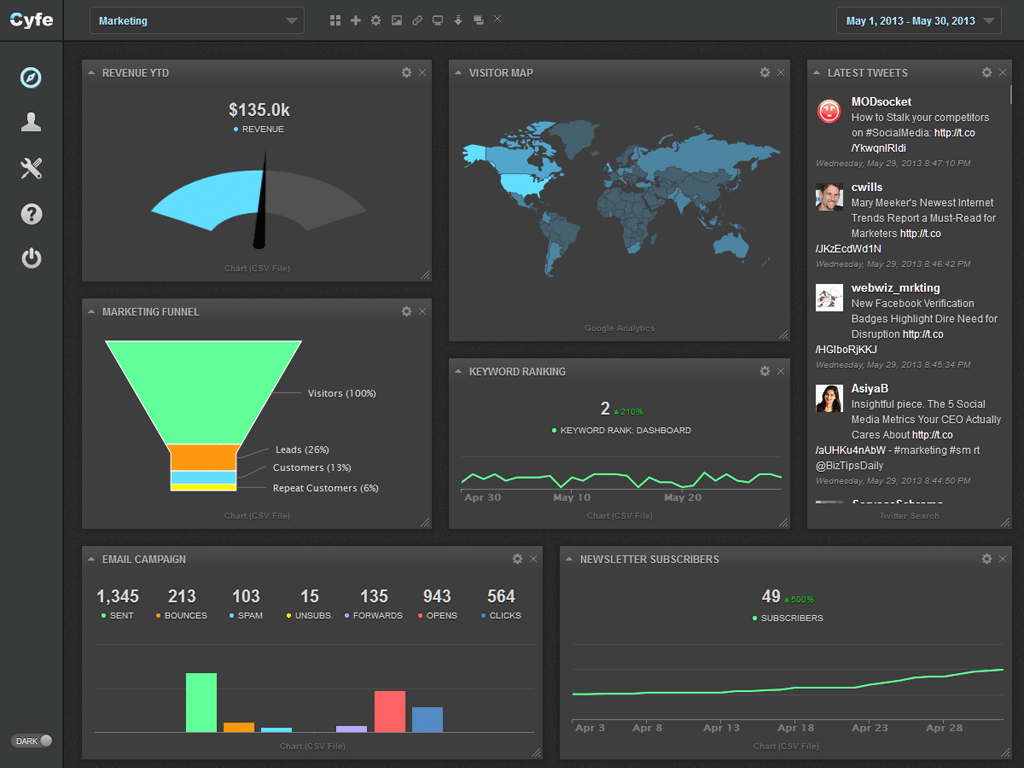The fact of the matter is – and if you’ve ever looked into using Google Analytics before, you’ll no doubt be very happy to read this – Google Analytics provides far, far too much information for those of us who only require a relatively brief synopsis of our website visitor statistics. Nevertheless, if you cut through the c..p, you can find some numbers that will most certainly prove very useful in terms of being able to find out who your customers or potential customers really are.
In this article, I will assume you already have Google Analytics installed on your website. If not, then here’s a video explaining how it’s done:
Website Goals and Why They Are Important
Goals – we all need some sort of goals in life and it’s no different for a website, no matter what type of site it is. We had a look at a variety of types of goals in our previous article about calls to action or CTA’s. The simple fact is, if your site lacks goals, it’s not going to be an efficient business tool. Let’s consider a variety of goals that you may wish to use on your website.
Micro Conversion
Firstly, you may well be wondering what is ‘micro conversion’? Bit of a confusing sounding term, admittedly so. Micro conversion is where we focus on what website visitors are ‘doing’ on our sites. They may indeed be there to buy something, which possibly is our ultimate goal. On the other hand, they may be visiting the site to get some form of support for a previously purchased product. Or they may be researching a product or service that we offer on our site.
In terms of CTA’s – calls to action, remember? – micro conversion CTA’s can be crafted in order to get a Facebook Like from a visitor, whereby they share our information with their Facebook followers – friends, family, acquaintances, whatever… Or, our CTA may entice a site visitor to sign up to a newsletter, whereby we mail them details of services, products, etc. from time to time. In other words, we are hoping to form a relationship with our newsletter subscribers. Get them to trust us more.
With micro conversions, you’ll be measuring ‘multi-channel impact’ that can stretch well beyond your site. You get to understand your website visitor’s persona, to figure out what it is that they actually want from your business. So, in essence, you’re not merely focusing on sales, you are focusing on a number of different statistics, which actually means you’re getting an idea about just how successful (or unsuccessful) your website actually is.
To further clarify, how about this… micro conversions can be site navigation based conversions, site engagement based conversions, or website interaction based conversions.
Macro Conversion
Now, conversely, macro conversions focus on overall conversion statistics. Does that help to clarify, or serve to mystify? Macro conversions can be seen as a primary conversion on your site. Example – a lead generation form sign-up or perhaps a completed sale. Now, in terms of CTA’s, we can use lead generation CTA’s or sales CTA’s for example, as you might expect, of course.
Macro conversions may include website revenue based conversions, site enquiry conversions, or website lead based conversions.
Setting up Goals in Google Analytics
Honestly, I could note down how to do this step by step, but then, Google has already completed that task for me, so it makes sense to direct you to their webpage instead. And here’s the link for this. If you did read through that stuff, then you best go get yourself a couple of pain killers because I suspect you’ve got a migraine coming on!
If you are more the video fanatic, and I’d say that watching a video on this subject makes for a far, far easier life than reading that thoroughly boring diatribe on the Google site (sorry Google, but it’s true), then this short video presentation by Jane Hinchey will be more your cup of tea:
What Are the Key Metrics to Determine – Using Google Analytics?
There are seven of key metrics, namely:
- Overall number of visits to your website (number of unique visitors)
- Overall number of page views per visitor
- The bounce rate (bounce rate is where someone clicks through to your site and immediately clicks away without viewing any further webpages)
- Duration of the visit/ amount of time spent on the website
- Exit rate – not to be confused with bounce rate (also not to be confused with the same term as it’s applied to the oil and gas industry. In our case, exit rate means the percentage of visitors to our website who click onto at least one other page of our site, and then click on a link within that secondary page to move onto another site)
- Goal conversion rates
- Goal completion rates
With information about these seven key metrics, you will be in a very healthy position to then optimize your content as well as your overall website. Information, after all, is power!
Top 3 Ways How to Analyze Data Using Google Analytics
Traffic Source Analysis
Traffic source analysis allows us to determine if we are driving the ‘right’ source of traffic/ visitors to our website. With this sort of information to hand, we can further optimize our ROI.
In this instance, we’ll be checking out stats on the following:
- Social media traffic (Facebook, Twitter, LinkedIn, for example)
- Search engine traffic (Google, Bing, Yahoo, being the big three players in the search engine game). At a deeper level, we’d also wish to assess which keyword phrases are driving the most traffic to our website, and which keyword phrases do we wish to rank for in future within the search engines
- Social bookmark referrals (StumbleUpon, Digg, Reddit, Del.icio.us, for example)
- Media referrals (YouTube (video), Flickr (images), podcasts (audio))
Top Page Analysis
By analyzing visitor stats on our top pages, or most viewed pages (usually that would be the site’s homepage for starters), we can gauge whether or not our page content is producing the sort of results that we wish. It’s wise to begin with the analysis of the top pages earlier on, since that’s where most of our visitors arrive to our site.
Landing Page Analysis
By analyzing our landing pages, we can get a fairly rapid idea if those pages are actually engaging our visitors. If they are not, then we need to figure out exactly why and then make the appropriate changes.
Google Analytics Dashboard
What does the Google Analytics Dashboard tell us? Have a look for yourself and you’ll see – it’s self-explanatory, really. Furthermore, you can copy it and paste it into your web browser. By using it, it will help you to focus on the more important metrics. Simply click on the link below and, if you’re already using Analytics, choose which website you wish to work with from the ‘Choose a View’ drop-down menu.
In the box, add a name for your dashboard, then click the ‘Create’ tab. That’s all there is to it…
https://www.google.com/analytics/web/template?uid=zBaqN1mYQtCcTahshvTeig
Google Analytics – Taking Things to the Next Level
So, let’s say you’ve gained a decent grasp of the basics and you wish to find out more about your website’s visitor stats, you can for sure go the extra mile and get your teeth really stuck into the extra-juicy parts. Here’s a great guide on how you could do just that:
http://www.simplybusiness.co.uk/microsites/google-analytics-guide/
Yes, Google Analytics does at first glance appear to be very tricky to come to terms with. And yes, analyzing website traffic stats and what have you can be a full time job in itself. However, the key to success is not in the nitty-gritty.
It’s far better to work with the most important metrics and leave the rest of it behind. After all, you’re trying to run a business, not develop yourself into graduating at doctorate level for website statistics. Don’t be tempted to get bogged down with this because, really, it would not be a wise investment of your precious time.







